Full Guide to Marjoram

Quick links to save you time
What is Marjoram?
Marjoram is a perennial herb or undershrub with sweet pine and citrus undertones. This herb is related to oregano and frequently appears in blends like herbes de Provence and za’atar. People grow Marjoram primarily for its flavorful leaves, which chefs use in green and dried cooking forms. Marjoram also has medicinal benefits, aiding in the relief of digestive problems, infections, and painful menstrual periods.
What Does Marjoram Look, Smell, and Taste Like?
Marjoram has light green, somewhat oval leaves that grow in pairs on its delicate stems.
The leaves have the same fuzzy texture as oregano but are more elliptical and rounded.
It has an earthy and woodsy flavor with balsam-like pine and citrus notes.
Marjoram has a sweet flavor due to a natural chemical called Sabinene hydrate. The sweetness mixes with hints of pine and citrus.
Its flavor is similar to oregano but has more complicated flavor notes and is sweeter, more delicate, or subtle. It lacks oregano’s spicy undertones.
It’s like oregano when fresh but much more floral and fruity. It has a pleasant herbal/floral smell and taste.
Marjoram is best for lighter dishes, like chicken or fish. You can use oregano as a substitute if you desire a stronger or spicier taste.
The flavor of Marjoram diminishes with cooking time.
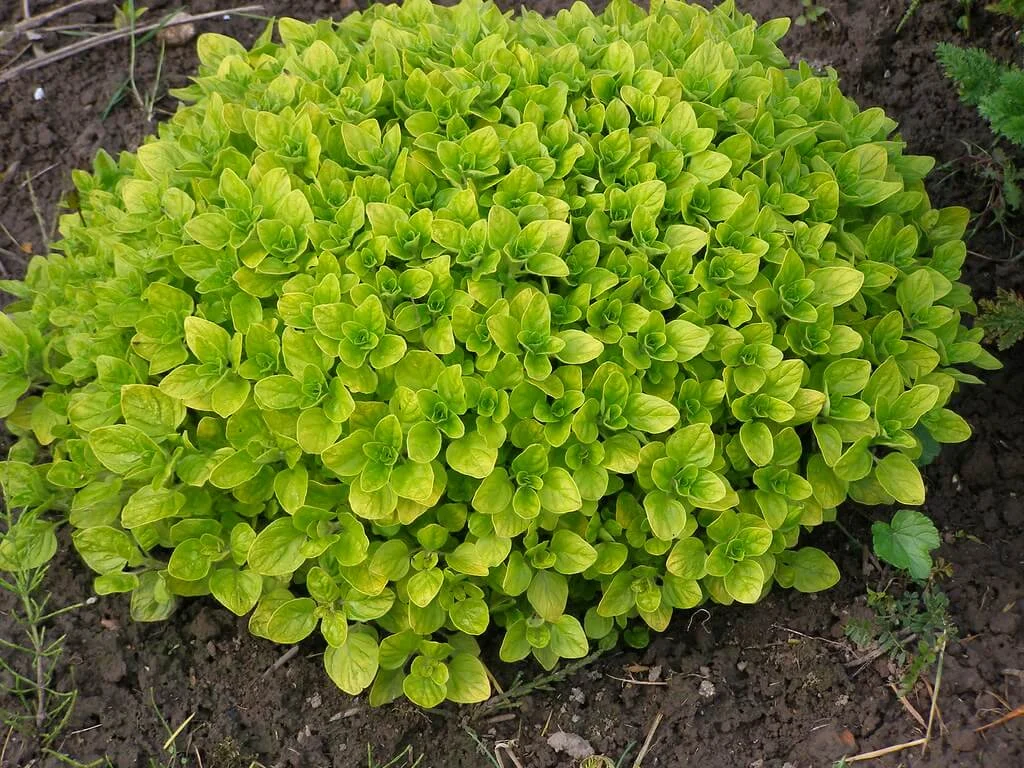
What are the Benefits and Therapeutic Uses of Marjoram?
Marjoram has several benefits and therapeutic uses. While many claim benefits from using Marjoram, it’s always best to consult a healthcare professional before using it, especially in its essential oil form. Please also read the section on the precautions for using Marjoram right after this section.
There is another section at the end, with the main sources I used to write this article. I encourage you to always consult with a health professional when in doubt. Information we can read on the Internet is an aid, but not a substitute for professional health advice.
7 Health Benefits and Therapeutic Uses of Marjoram
- Hormonal Health: Marjoram might promote hormonal health, particularly for women. Research indicates that women with polycystic ovarian syndrome (PCOS) can enhance insulin sensitivity and decrease adrenal androgen levels by drinking marjoram tea twice a day for a month.
- Anxiety Relief: Marjoram shows potential in reducing anxiety. For individuals who grind their teeth, known as bruxism, using marjoram oil in aromatherapy boosted the anxiety-lowering impact of neurofeedback training.
- Antimicrobial Activity: Numerous research pieces highlight marjoram’s antimicrobial capabilities. One study revealed that marjoram essential oil combats a broad spectrum of infectious bacteria. Another study showed marjoram oil as a potent alternative treatment for urinary tract infections (UTIs) resulting from E.coli bacteria.
- Digestive Health: In cooking, as a tea, or in its popular therapeutic form as an essential oil, marjoram aids digestion. It aids in relieving digestive problems like bloating, gas, and constipation.
- Respiratory Health: Marjoram acts as a nervine, a herb bolstering the nervous system and battling anxiety and stress. It has a profoundly soothing impact on the body and can even foster sensations of joy.
- Antioxidant and Anti-inflammatory Properties: Marjoram possesses numerous anti-inflammatory and antimicrobial qualities. People have used it to remedy diverse health concerns such as digestive problems, infections, and discomfort during menstruation. It has antioxidant effects and may help reduce inflammation in the body.
- Other Uses: Marjoram has been used to treat cancer, colds, coughs, cramps, depression, as a diuretic, ear infections, gastrointestinal problems, headaches, and paralysis, as well as arthritis, chest congestion, and muscle aches. As always, I am not a doctor, so please consult a health professional if you have doubts or suffer from any medical condition. You can consult the sources I used at the bottom of this article.
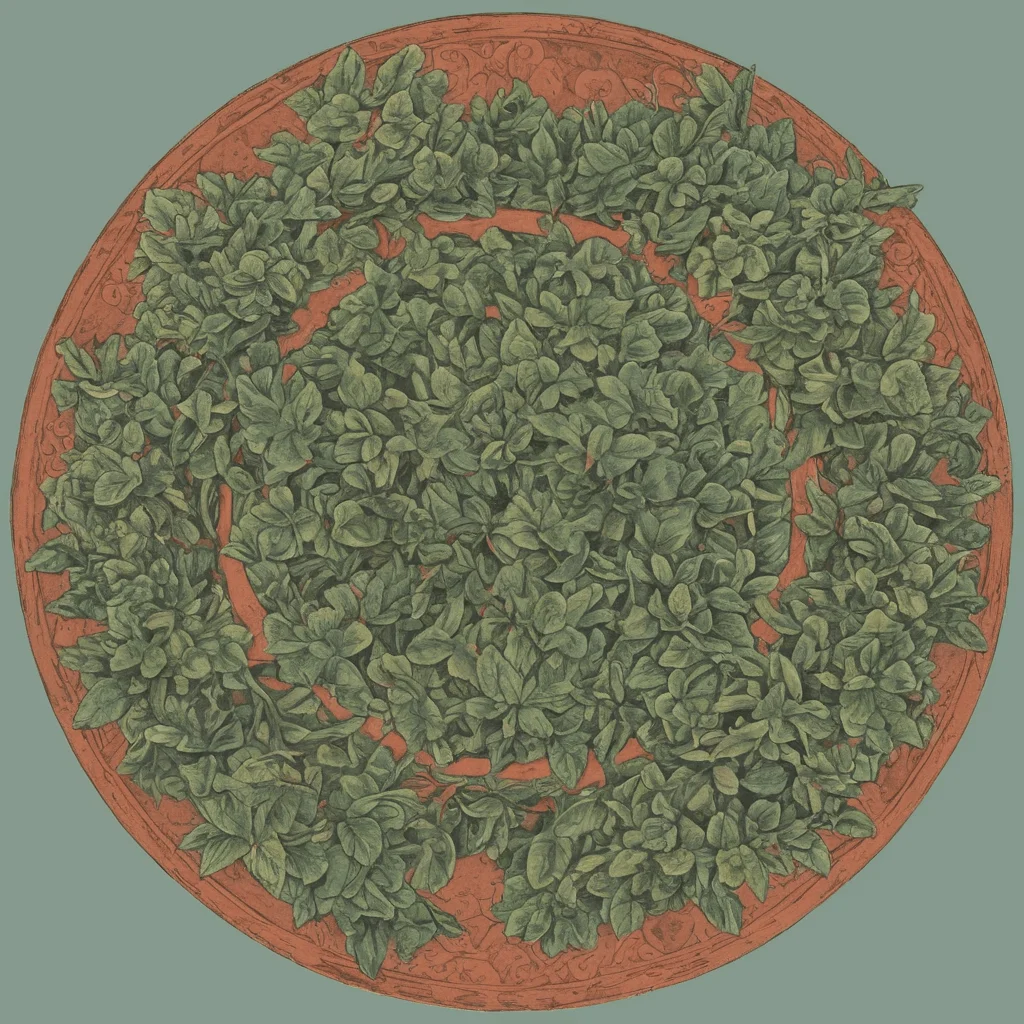
Credit Alberto Conde, Kitchen In The Med
Marjoram Precautions and Contraindications
- Long treatments: You shouldn’t use marjoram for medicinal purposes for longer than two weeks. Continued use may cause headaches and drowsiness.
- Sensitive skin: People with sensitive skin might experience contact dermatitis from Marjoram.
- People with digestive disorders: Because of its aromatic compounds, marjoram might trigger flare-ups and digestive issues in individuals with inflammatory bowel disease, Dumping syndrome, irritable bowel, and Crohn’s disease.
- People with blood in the urine: Avoid using it if you detect hematuria or blood in the urine.
- Children under six years: Children under six shouldn’t use marjoram essential oil or the plant for medicinal purposes due to the risk of allergies and bronchospasm.
- Pregnancy and breastfeeding: Marjoram is possibly unsafe in medicinal amounts when pregnant. Marjoram could induce menstruation, potentially jeopardizing the pregnancy. Women who are pregnant or breastfeeding should steer clear of marjoram supplements.
- Lung conditions: Marjoram may boost lung fluid secretions in medicinal quantities. This issue raises worries that it could exacerbate lung conditions like asthma or emphysema.
- Seizure disorder (epilepsy): Given Marjoram’s impact on brain chemicals, it might aggravate epilepsy. If you suffer from a seizure disorder like epilepsy, exercise caution when using marjoram.
- Surgery: Consuming Marjoram in medicinal doses may heighten the bleeding risk during and post-surgery. Please do not use it medicinally at least two weeks before a scheduled surgery.
- Urinary tract or reproductive system blockage: Marjoram can exacerbate urinary or reproductive system blockages. This problem is due to its ability to boost mucous and fluid secretions in these organs, leading to “congestion.” If you face blockages in the urinary tract or reproductive system, approach marjoram cautiously.
- It is important to note that you should not use Marjoram as a replacement for medical treatment. If you consider using marjoram for medicinal purposes, consult a healthcare professional first.

Credit Alberto Conde, Kitchen In The Med
What Part of the Marjoram Herb is Edible?
The leaves of the marjoram herb are edible and are the most commonly used part of the plant in cooking.
People use them fresh or dried, and they are popular as a seasoning ingredient in food.
Fresh marjoram leaves are preferable for cooking as dried leaves often diminish flavor and scent. To preserve their taste, add them near the conclusion of the cooking phase, as heat can degrade their flavor.
You can use the flowers to make tea, but it doesn’t taste as pleasant as the one made with leaves.
People use the aromatic seeds to flavor sweets, beverages, and desserts.
10 different types of Marjoram and their uses
While there is no concrete number of how many different types of Marjoram there are, these are ten of the most used varieties:
- Sweet Marjoram (Origanum majorana): This variety is the most common type in cooking. It has a sweet, mild flavor in herb blends like Herbes de Provence and za’atar. It pairs well with meats, vegetables, and soups.
- Pot Marjoram (Origanum onites): This type of marjoram has a more robust flavor than sweet Marjoram and is popular in Greek and Turkish cuisine. It is common in meat dishes, stews, and sauces.
- Wild Marjoram (Origanum vulgare): Also known as common oregano, this type of marjoram has a potent, spicy flavor and is often used in Italian and Mediterranean cuisine. You will notice it in pizza, pasta, and tomato-based dishes.
- French Marjoram (Origanum onites): This type of marjoram has mid-green leaves that turn to gold in the summer. It produces pink-white flowers and is popular in pasta and meat dishes.
- Gold-Tipped Marjoram (Origanum vulgare): This type of marjoram features green leaves with gold tips and pink flowers. It tastes excellent in pizza and vegetable dishes.
- Compact Marjoram (Origanum compactum): This type of marjoram has a robust and spicy flavor and is often present in Moroccan cuisine. It is common in meat dishes, stews, and sauces.
- Greek Marjoram (Origanum heracleoticum): This type of marjoram has a potent, spicy flavor and is popular in Greek cuisine. It is present in meat dishes, stews, and sauces.
- Italian Marjoram (Origanum x majoricum): This type has a sweet, soft flavor and is popular in Italian cuisine. It is common in tomato-based dishes, pasta, and pizza.
- Spanish Marjoram (Thymus mastichina): This type of marjoram has a robust and spicy flavor and is popular in Spanish cuisine. It is present in meat dishes, stews, and sauces.
- Mexican Marjoram (Lippia graveolens): This type of marjoram has a potent, peppery flavor and is popular in Mexican cuisine. It is present in meat dishes, casseroles, and sauces.

Credit Alberto Conde, Kitchen In The Med
5 Main Culinary Uses of the Marjoram Herb:
Using fresh marjoram leaves in cooking is ideal, as the dried ones often see a reduction in flavor and scent. Since heat can spoil their taste, it’s wise to incorporate them near the end of your cooking routine.
- Seasoning: Marjoram can be a substitute for oregano in cooking. The taste is softer and sweeter than oregano, with a slightly woodsy fragrance. People use it to season soups, stews, marinades, salad dressings, sauces, and meat and vegetables.
- Tea: Marjoram also tastes fantastic as a tea and has many benefits. Brew fresh or dried leaves for a fragrant herbal tea that’s delicious and healthy. You can also brew the flowers into tea. However, it doesn’t taste as pleasant as the tea made with leaves.
- Flavoring: The fragrant seeds of Marjoram are suitable for flavoring sweets, beverages, and desserts.
- Meat dishes: Marjoram is famous for seasoning sausages, meats, poultry, stuffings, fish, braises, eggs, vegetables, and salads.
- Italian cuisine: Marjoram is indispensable for Italian cuisine. It is common in tomato-based dishes, pasta, and pizza.
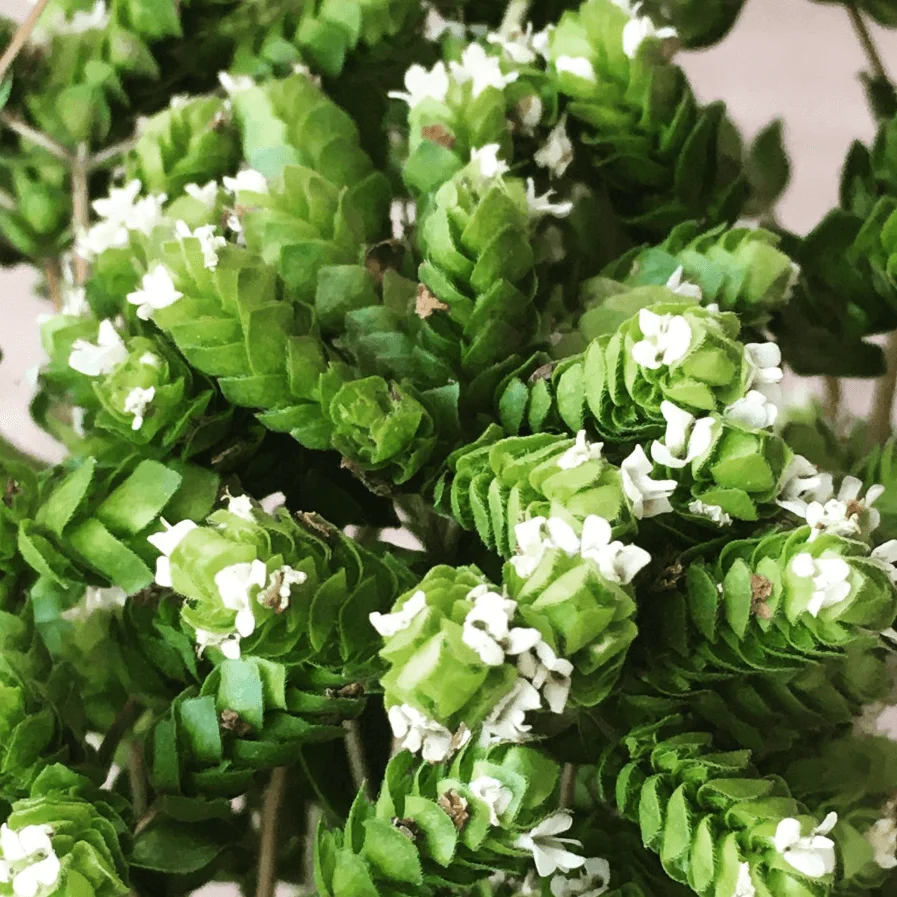
Marjoram compared with 10 other seasoning herbs:
- Oregano: Oregano is a close relative of marjoram and has a similar flavor profile but is stronger and more intense. It is present in Italian and Greek cuisine, particularly in tomato-based dishes, pizza, and pasta.
- Parsley: Parsley has a fresh, grassy flavor and is popular as a garnish or to add flavor to soups, stews, and sauces. It is frequent in Mediterranean and Middle Eastern cuisine.
- Rosemary: Rosemary has a strong, woody flavor and is commonly used in meat dishes, particularly lamb and chicken. It is also common in Mediterranean and Middle Eastern cuisine.
- Bay leaves: Bay leaves have a subtle, earthy flavor and are prevalent in stews, braises, and seasonings. They are also common in Mediterranean and Middle Eastern cuisine.
- Dill: Dill has a fresh, tangy flavor and is common in pickling and Scandinavian and Eastern European cooking. It is also present in salads, soups, and sauces.
- Thyme: Thyme has a robust and earthy flavor and is present in meat dishes, particularly beef and lamb. It is also common in Mediterranean and Middle Eastern cuisine.
- Sage: Sage has a strong, slightly bitter flavor and is good in meat dishes, particularly pork and poultry. It is also present in Mediterranean and Middle Eastern cuisine.
- Basil: Basil has a sweet, slightly peppery flavor and is vital in Italian and Mediterranean cuisine, particularly in tomato-based dishes, pasta, and pesto.
- Mint: Mint has a fresh, cool flavor and is very popular in Middle Eastern and Southern Mediterranean cuisine, particularly in salads, sauces, and teas.
- Cilantro: Cilantro has a fresh, citrusy flavor and is indispensable in Mexican and Asian cuisine, particularly salsas, guacamole, and curries.
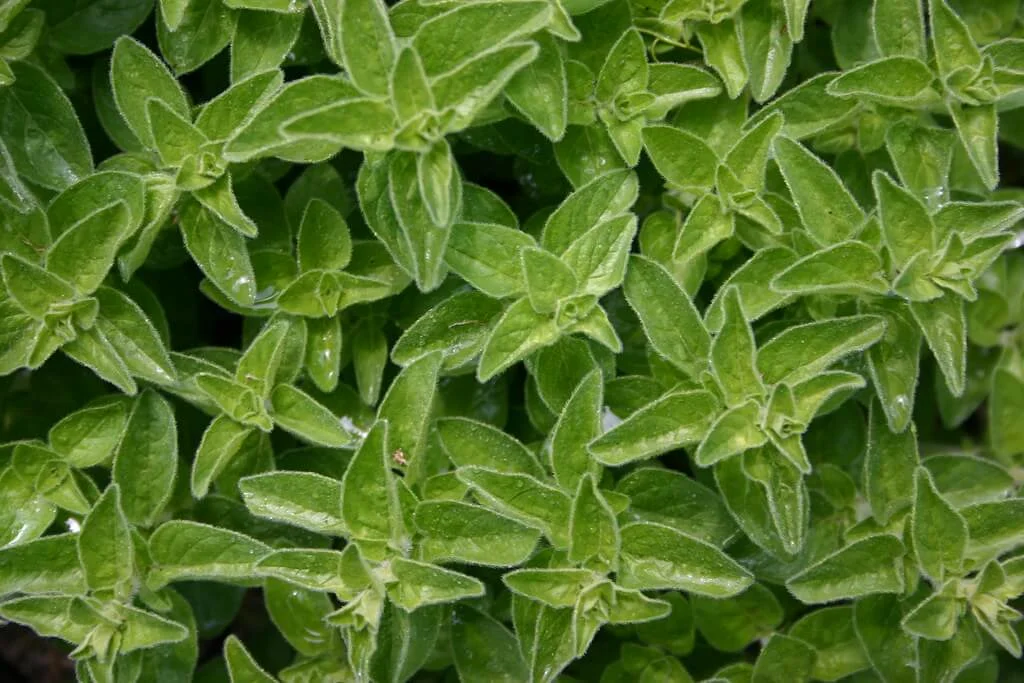
Marjoram as an Insect Repellent
While Marjoram can be an insect repellent, it is essential to note that there is insufficient reliable information to know if it is safe when applied to the skin. Some people are allergic to Marjoram, which may cause skin irritation or allergic reactions.
Insecticidal activities: According to a study, sweet Marjoram has insecticidal activities against Pediculus humanus capitis, the scientific name for head lice.
Natural insect repellent: Marjoram can be a natural insect repellent. To make a natural insect repellent using Marjoram, you can follow these steps:
- Ingredients: One cup of fresh marjoram leaves, two cups of water, one tablespoon of liquid soap (preferably organic).
- Instructions: Harvest fresh marjoram leaves and chop them finely. Bring two cups of water to a boil and add the chopped marjoram leaves. Let the mixture steep for 30 minutes. Filter the mixture and mix in one tablespoon of liquid soap. Mix well and pour the mixture into a spray bottle. Spray the mixture on your skin or clothes to repel insects.

Sweet Marjoram essential oil:
Sweet Marjoram essential oil can also be an insect repellent. Remember that some people can be allergic to essential oils when applied to the skin.
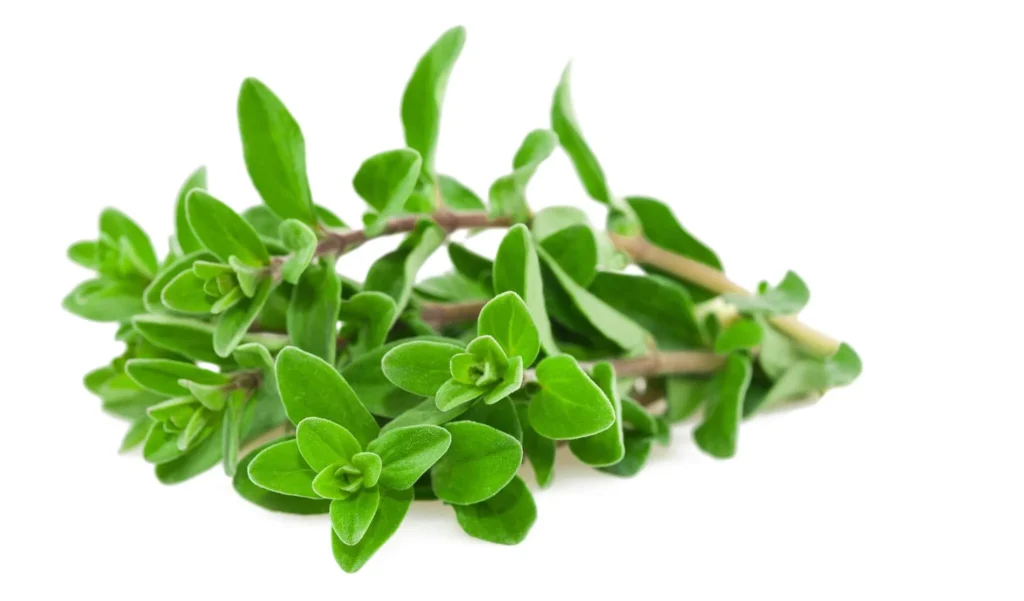
What is Marjoram Essential Oil Good for?
- Digestive health: People have used marjoram essential oil to enhance digestion and address digestive issues like bloating, constipation, and indigestion. It can also help stimulate the appetite and relieve nausea.
- Heart health: Marjoram essential oil improves blood flow and lowers blood pressure. It can also help reduce cardiac strain and decrease blood pressure by lowering sympathetic nervous system activity and stimulating the parasympathetic nervous system.
- Respiratory health: People have turned to marjoram essential oil to address respiratory issues like coughs, colds, bronchitis, and sinusitis. Additionally, it offers relief for tension headaches and migraines.
- Pain relief: Marjoram essential oil possesses pain-relieving qualities and effectively alleviates pain from menstrual cramps, muscle soreness, arthritis, and back discomfort.
- Calming and relaxing: Marjoram essential oil calms the nervous system and aids in diminishing stress and anxiety. It can also foster a sense of joy and curtail obsessive thoughts.
- Aromatherapy: Marjoram essential oil is commonly used in aromatherapy to promote relaxation and reduce stress. It has a warm, herbaceous, and woody aroma helps create a calming atmosphere.
- Culinary uses: Marjoram essential oil can be a flavoring agent in cooking, particularly in stews, dressings, soups, and meat dishes. It can take the place of dried Marjoram when cooking.
Is Marjoram Essential Oil Used for Cooking?
Yes, people use Marjoram essential oil for cooking. Marjoram oil’s herb-like taste can enhance stews, dressings, soups, and meat dishes, serving as an alternative to dried Marjoram in cooking.
Marjoram essential oil is popular in the Mediterranean and Italian cuisine.

The 10 Most Frequently Asked Questions About Marjoram
What is Marjoram?
Marjoram is a perennial herb or undershrub that has sweet pine and citrus undertones.
What does Marjoram look, smell, and taste like?
Marjoram has an earthy and woodsy flavor with balsam-like pine and citrus notes. It has a warm, herbaceous, and woody aroma.
What are the benefits and therapeutic uses of Marjoram?
Marjoram has several health benefits and medicinal uses, including digestive health, heart health, respiratory health, pain relief, calming and relaxing, aromatherapy, and culinary uses.
What are Marjoram's contraindications?
You should not use it during pregnancy or breastfeeding, and it may cause skin irritation or allergic reactions in some people. It may also slow clotting and increase the chances of bruising and bleeding in people with bleeding disorders.
What part of the marjoram herb is edible?
The leaves of the marjoram herb are edible and are the most commonly used part of the plant in cooking.
Can marjoram essential oil be used for cooking?
Yes, people use Marjoram essential oil for cooking. It can be used as a flavoring ingredient, particularly in stews, dressings, soups, and meat dishes.
Is Marjoram essential oil good for anything?
Marjoram essential oil has several uses and benefits, including pain relief, digestive health, heart health, respiratory health, calming and relaxing, aromatherapy, and culinary uses.
How can Marjoram be used as an insect repellent?
Marjoram is a natural insect repellent. You can make it into a spray by boiling fresh marjoram leaves, straining the mixture, adding liquid soap, and pouring it into a spray bottle.
What are some culinary uses of Marjoram?
Marjoram is common in cooking, particularly in Mediterranean and Italian cuisine. It is a popular ingredient to season soups, stews, marinades, salad dressings, sauces, meat, and vegetable dishes.
How does Marjoram compare to other seasoning herbs like oregano, parsley, and rosemary?
Marjoram has a milder, sweeter flavor than other seasoning herbs like oregano, parsley, and rosemary. It is popular as a substitute for oregano in cooking.
Main Sources I used in This Article
Library of Science, Open Access - Uniwersytet Przyrodniczy w Lublinie
The University of Chicago Press Journals
Wiley Online Library
European Journal of Lipid Science and Technology
Flavour and Fragrance Journal
Essential oil compounds in a historical sample of marjoram (Origanum majorana L., Lamiaceae)
